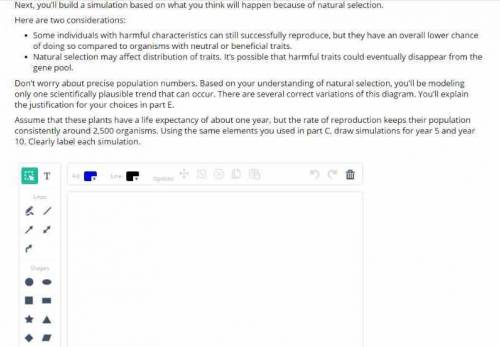
Help I'm using Plato and I need this to pass.
Next, you’ll build a simulation based on what you think will happen because of natural selection.
Here are two considerations:
Some individuals with harmful characteristics can still successfully reproduce, but they have an overall lower chance of doing so compared to organisms with neutral or beneficial traits.
Natural selection may affect distribution of traits. It’s possible that harmful traits could eventually disappear from the gene pool.
Don’t worry about precise population numbers. Based on your understanding of natural selection, you’ll be modeling only one scientifically plausible trend that can occur. There are several correct variations of this diagram. You’ll explain the justification for your choices in part E.
Assume that these plants have a life expectancy of about one year, but the rate of reproduction keeps their population consistently around 2,500 organisms. Using the same elements you used in part C, draw simulations for year 5 and year 10. Clearly label each simulation.


Answers: 2


Another question on Biology


Biology, 21.06.2019 23:00
Based on the data in your tables, did the light-colored moths have a higher or lower survival rate after the industrial revolution?
Answers: 1

Biology, 22.06.2019 00:30
Experiments in environmental toxicology can sometimes be manipulative experiments in which the researcher actively chooses and manipulates the independent variable. in hunt's study, for example, dosages of bpa were manipulated and the effects were measured. in manipulative studies, the researcher controls all the other variables in the experiment, so any health effects observed in the test subjects can be attributed to differences in the independent variable. in other cases, researchers use natural experiments in which the dependent variable (typically a measure of organism health) is measured under differing contexts that are not manipulated. say, for example, that an accidental chemical spill contaminates five ponds. to determine the possible effects of the toxic chemical on frogs, a researcher could compare the hatching rate of frog eggs laid in those five ponds to the hatching rate of eggs laid in five uncontaminated ponds nearby. this would be an example of a natural experiment because concentrations of the toxic chemical in the ponds were not controlled by the experimenter, but rather resulted from the chemical spill. drag type of experiment on the left to the example of experiment on the right. blood concentrations of bpa in college students are compared to their recent manipulative consumption of canned food items 2. the feeding behavior of fish in streams that receive acidic runoff from strip mines is compared to the feeding behavior of fish in unaffected streams. the deformity rate in baby birds from nests in pesticide-sprayed fields is compared to the deformity rate in birds from nests in unsprayed fields 4 tumor development is compared in mice exposed to five dosages of a known carcinogen in the laboratory foraging activity levels are compared in tadpoles exposed to four concentrations of toxic metals in the laboratory. growth of corn plants is compared in field plots sprayed with three different dosage: s of weed killer 7 bpa concentrations in the urine of people with diabetes are compared to bpa concentrations in the urine of people without diabetes - natural; manipulative
Answers: 1

Biology, 22.06.2019 04:00
Number and variety of living organisms includes genetic, species, and ecological types
Answers: 3
You know the right answer?
Help I'm using Plato and I need this to pass.
Next, you’ll build a simulation based on what you thi...
Questions



History, 05.12.2019 18:31

Mathematics, 05.12.2019 18:31






Mathematics, 05.12.2019 18:31


Mathematics, 05.12.2019 18:31

History, 05.12.2019 18:31


Mathematics, 05.12.2019 18:31




Mathematics, 05.12.2019 18:31

Chemistry, 05.12.2019 18:31



